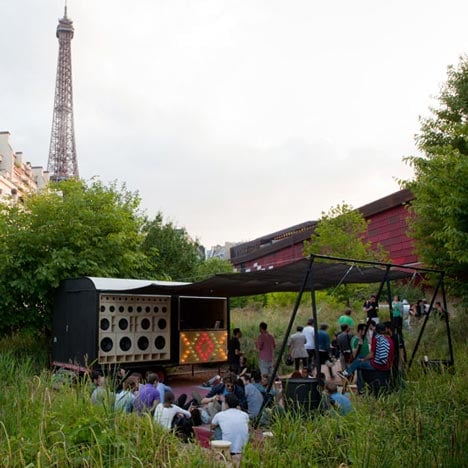This disco-cum-caravan is one of five timber-clad cabins installed by Swiss architects 1/100 in the garden of the Quai Branly Museum, Paris.
Each mobile pavilion folds open to reveal a different function, offering a sheltered information point, an ice cream vendor, a sound-system, a kindergarten and a stage.
Scattered across the site, the Nomad caravans are decorated with disco lights and surrounded by carpets, stools and chairs to encourage social gatherings.
At the end of the summer each caravan will be folded up and towed to a new location.
More stories about pavilions on Dezeen »
Photography is by Thomas Mailaender.
Here are some more details from the architects:
NOMAD
Museum Quai Branly, Paris
The installation NOMAD squats the garden of the Museum Quai Branly for the summer months. It inhabits the site from the 4th of June to the 4th of September, before continuing its journey.
The installation NOMAD chooses to inject programm into a hyperarchitectural environment. This programmatic occupation of the site will last the summer months, taking advantage of the highly frequented garden. Caravans, tents, carpets and stools: informal architecture, assemblage of recycled and transformed objects, the installation enables the domestication and the appropriation of a garden originally thought to be admired. Lightweight and mobile, five informal settlements provide spaces for events, refreshments and subsistence. Spread along the paths, in the glades and under the museum ship, they trigger interactions and create a new field of relationships. In the heart of the city, the dense vegetation is the set of a temporary occupation. Without fences nore measurements, this territory is redefined, held, inhabited for a time.
Second-hand caravans, transformed and tuned, build the heart of those mobile units. They offer shelter to an info point, a sound-system, an ice cream van, a kindergarden and a stage, programs chosen for they capacity to generate interactions. Agricultural canvas, tight to the caravans, offer shade to an inviting floor of colorful carpets. Lightweight foldable wood furniture, inspired from the museum collections, can be spread according to needs. Detached from their context and aesthetized by the museography, many domestic objects presented in the musem exhibitions have lost any relation with their original function. Inspired by the collections, the furniture created for NOMAD desacralizes and reintegrates those objects to where they belong, everyday life. The whole deployement can be removed in no time and leave the site without any marks. An architecture without bonds, but not without history or territory: the caravans and their inhabitants, removed for a while from the national landscape, are integral part of the European culture - and way before this summer of 2010, when France hunted them down.
Museum of Arts and Civilisations, museum of Primal Arts, museum of Africa, Asia, Oceania and Americas? Let’s call it Museum of Quai Branly, this would avoid any ambiguity and misunderstanding. Beyond a polemic of designation, this is an institution which chooses to focus on extra-european cultures, however defining itself as a place where cultures are in dialogue. But the monologue is not a variant of the dialogue. This fixation on the exotic risks to block any parallels, any cultural exchanges and, above all, to impede any reflexion on occidental practices and cultures. The project chooses then to fight against an euro-centrist vision of culture and its bigoted evolutionism. Indeed, if it is far from being absurd to expose those fascinating objects coming from cultures that we definitively know too less, their display should jeopardize our position - otherwise it is purely aesthetics.
At a time when a billion humans are migrating throughout the world, often involuntary, nomadism becomes the horizon of art and society. It is about not looking away, about doing an humble autocritic, as from now on we recognize nomadism as part of our own culture, integrated in globalization.
NOMAD stops in the garden of the Museum Quai Branly to affirm contextualization against esthetization, diffusion against centralization, emancipation against homogeneization.

